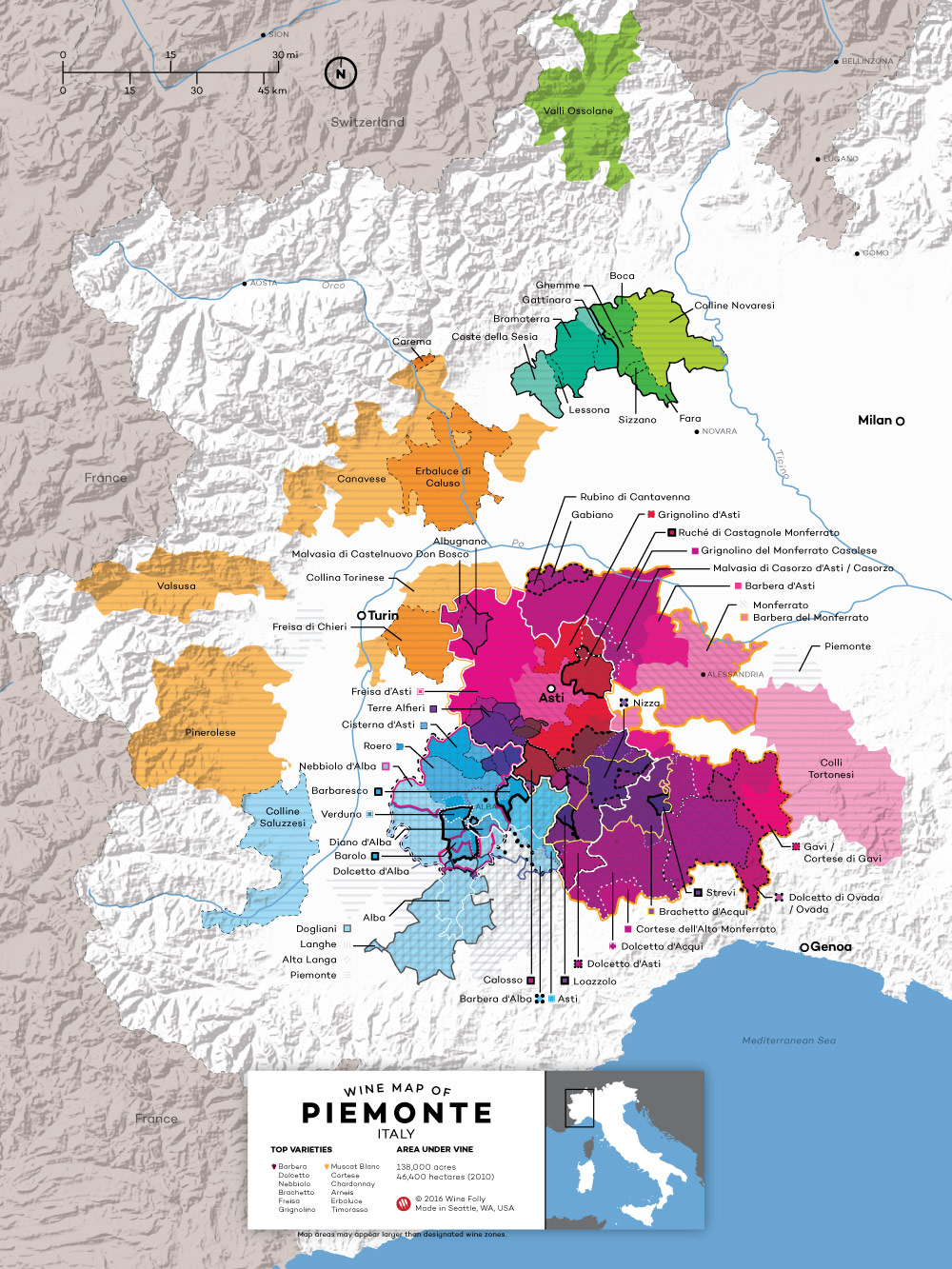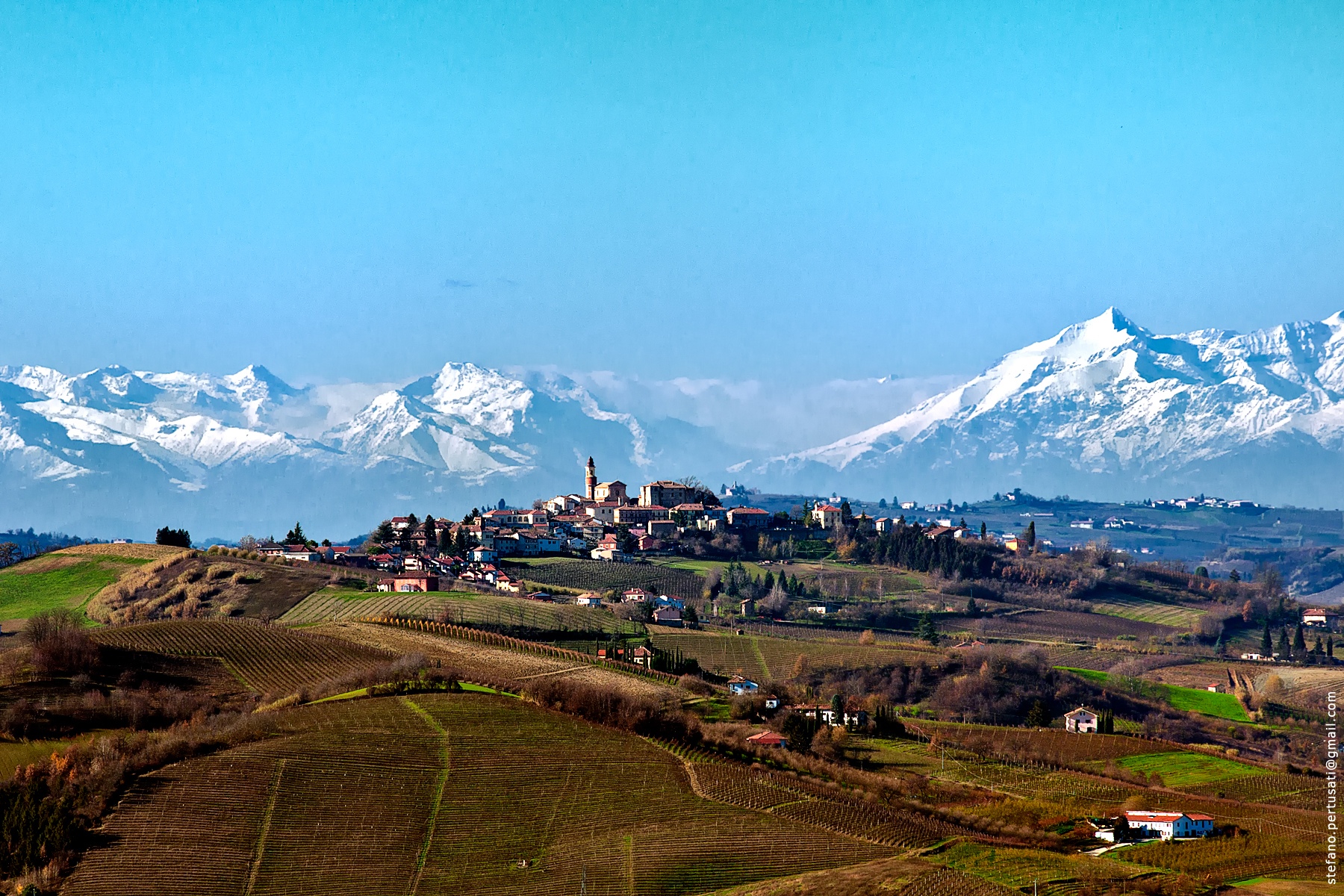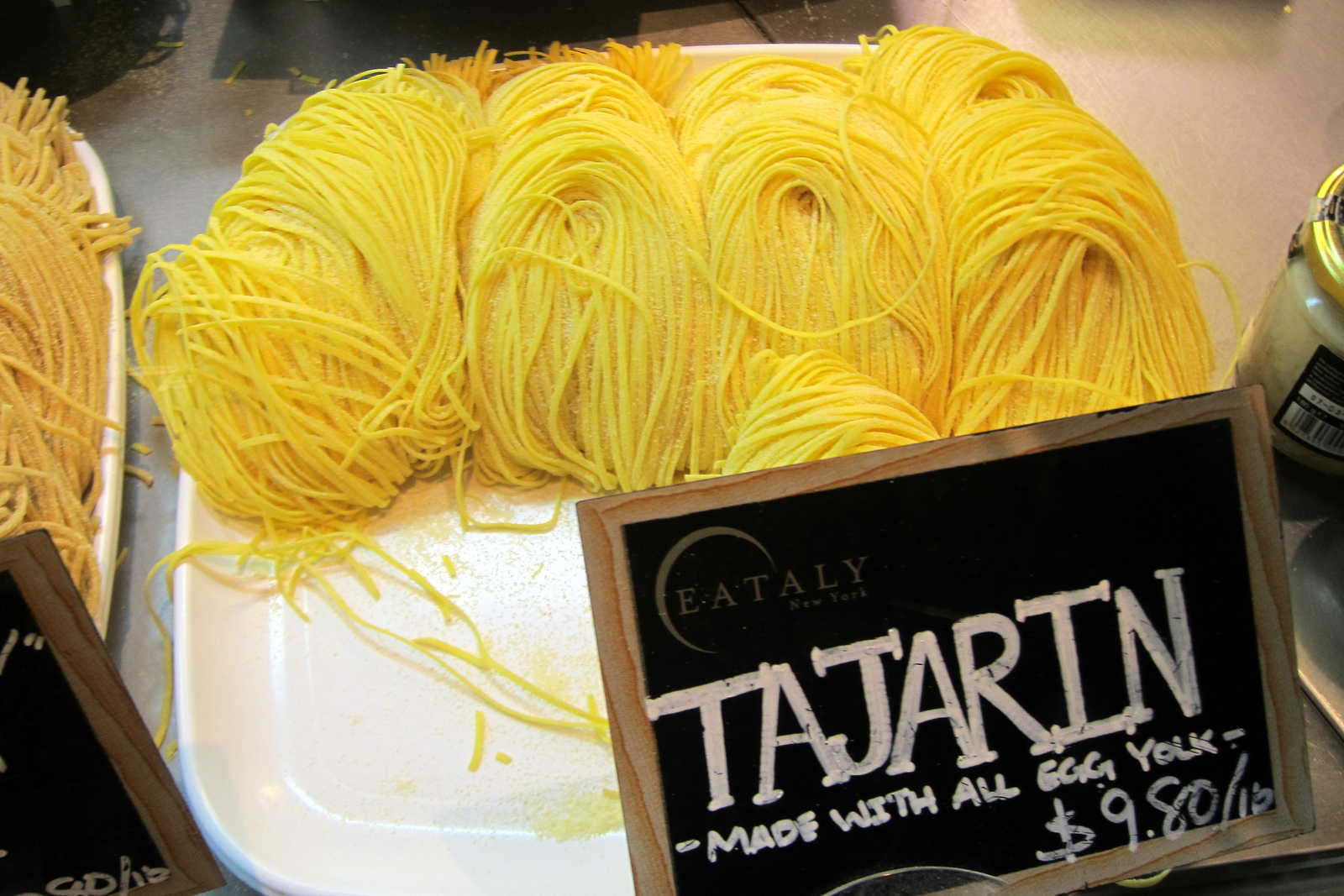One of the best ways to explore Piedmont (or, as they say in Italian, “peh-ah-MON-tey”) is through its wines.
Drink your way through the region, and you’ll discover quite a range of styles, from the bold and age-worthy red wines of Nebbiolo to the delicate, sweet, fizzy white wines of Moscato d’Asti.
If you didn’t already know, Piedmont is one of Italy’s most acclaimed wine-growing regions. Of Italy’s 20 major wine regions, it ranks sixth in highest production volume.
It’s famous for high quality and produces more DOCG (Denominazione di Origine Controllata e Garantita — Italy’s top wine classification designation) wines than any other region.
There are 59 regions in Piedmont (including Barolo, Gabiano, Barbera d’Asti, etc.), and the region’s name is prominently listed on Piedmont wine labels (often alongside the variety).
While regional names are numerous and complex, there are only a dozen or so grape varieties that highlight the most important wines of the area. Getting to know these grapes (and their wines) is a great way to get acquainted with the Piedmont culinary style. You’ll discover that the wines perfectly complement the region’s meaty, truffle-forward, rustic recipes.
Piedmont DOC/DOCG Wine Map

Why Learn About Piedmont Wine?
If you’re aiming for a deeper understanding of Italian wine, Piedmont is one of the most useful wine regions to get to know.
For one, Piedmont introduces us to a completely new set of wine grapes to taste and understand – from Nebbiolo to Cortese.
Secondly, Piedmont is considered a top wine region in Italy (like Tuscany).
And finally, Piedmont is very popular with the locals in the Po River Valley. This area is home to one third of the population of Italy! (including Milan and Turin).

Piedmont Wine Guide
When wine geeks think of Piedmont, they immediately think of Barolo and Barbaresco, which are famous for their Nebbiolo-based wines.
Surprisingly, Barolo and Barbaresco only account for 3% of Piedmont’s production, so there’s quite a bit more to uncover!
Piedmont is cupped by the Alps to the North, and it looks like something out of a scene in Game of Thrones.
To the south, you’ll find the (less stunning) Apennines, which are more like a set of lumpy hills. Despite their modest stature, the slopes heading towards the Apennines are where you’ll find the quality wine production in Piedmont.
Why is Wine Better From the Hills in Piedmont? There are two major features affecting the weather in Piedmont: the ice-cold Alps and the warm Mediterranean. The tug-of-war (aka Diurnal) temperature variation makes the whole area fill up with morning fog that slowly burns off during the day.
This means the land higher up on the hills gets more sun. More sun = happy grapes = good wine. There are good wines to be found north of the Apennines in the foothills of the Alps. But since this area (around Gattinara) is much cooler, expect much lighter-tasting, higher-acid wines.
Red Wines of Piedmont
Below, you’ll see detailed notes on the major varieties and corresponding regional wines. Wines are organized by regional distribution, with the most widely planted varieties listed first.
Barbera
Barbera is the most planted variety in Piedmont, and it’s what the locals often drink. Great Barbera wines deliver aromas of red and black fruit (particularly raspberries, lingonberries, and blackberries), espresso, smoke, and fresh anise, supported by velvety tannins and a spicy finish.
The wines often age in oak to deliver richer, opulent fruit flavors, but most everyday Barberas are medium-bodied with a touch of spicy-earthy terroir. Despite the prevalence of this grape in the region, Barbera continually flies under the radar and usually offers good economic value.
Here are the regions that specialize in Barbera:
- Barbera d’Asti DOCG (90% min)
- Barbera d’Asti Sottozona “Nizza” DOCG (90% min)
- Barbera del Monferrato Superiore DOCG
- Barbera del Monferrato DOC
- Barbera d’Alba DOC
- Gabiano DOC (90–95%)
- Rubino di Cantavenna DOC (75–90%)
- Colli Tortonesi Barbera DOC (85% min.)
- Piemonte Barbera DOC (85% min.)
Dolcetto
Dolcetto is a bit of a misnomer because the word means “little sweet one.” However, it’s neither sweet nor little. Many love Dolcetto for its lower acidity and soft, fruity flavors of plums, blackberries, and raspberries. Dolcetto wine often has lifted floral aromas of violets and black peppercorn that contrast its firm tannin texture (that can come across as similar to chocolate).
Exceptional producers are found in both DOCG and DOC areas (especially Alba) and because of the lower acidity, most recommend drinking the wine within five years of release.
- Dolcetto di Ovada Superiore DOCG / Ovada DOCG (100%)
- Dolcetto di Diano d’Alba DOCG (100%)
- Dogliani DOCG (100%)
- Dolcetto d’Alba DOC (100%)
- Dolcetto d’Asti DOC (100%)
- Dolcetto d’Acqui DOC (100%)
- Dolcetto di Ovada DOC (100%)
- Langhe Dolcetto DOC (85% min.)
- Colli Tortonesi Dolcetto DOC (85% min.)
- Piemonte Dolcetto DOC (85% min.)
Nebbiolo
The most exalted red wine variety of Piedmont is Nebbiolo. This wine is striking to experience because its delicate, pale, brick-red color and floral cherry and rose aromas are a complete contrast to its somewhat aggressive, chewy tannins (particularly in wines from Barolo). Because of its structure, you’ll find that Nebbiolo wines are a favorite for collectors who will happily set aside wines to open them decades later to reveal a delightfully soft and delicate wine. Even though Nebbiolo has a reputation for tannins and long-term aging, many of the sub-regions (Langhe, Alba, etc.) produce softer styles with a similar weight to whole-cluster Pinot Noir.
- Barbaresco DOCG (100%)
- Barolo DOCG (100%)
- Ghemme DOCG (85% min.)
- Gattinara DOCG (90% min.)
- Roero DOCG (95% min.)
- Nebbiolo d’Alba (100%)
- Langhe Nebbiolo DOC (85% min.)
- Albugnano DOC (85% min.)
- Terre Alfieri DOC (85% min.)
- Boca DOC (70–90%)
- Bramaterra (50–80%)
- Carema (85% min.)
- Lessona DOC (85% min.)
- Valli Ossolane Nebbiolo (85% min.)
- Sizzano DOC (50–70%)
- Fara DOC (50–70%)
- Colline Novaresi (50% min.)
- Piemonte Nebbiolo DOC (85% min.)
The wines of Barolo age for at least 18 months in barrel and are released after a total of 3+ years.
- Tip Riserva level Barolo age for a minimum of 5 years.
- Tip Vigna on a label indicates a single vineyard wine.
- Tip The older the better; look for Barolo of 10+ years.
There are eleven different communes of Barolo with two different main taste styles (based on the soil type: limestone vs. sandstone).
The two communes to remember that are lighter in style are La Morra and Barolo with limestone-based soils. The communes of Serralunga d’Alba, Monforte d’Alba, and Castiglione Falletto are usually bolder from sandstone soils.
Brachetto
One of Piedmont’s most delightfully fruity and sweet red wines offers up aromas of strawberry purée, cherry sauce, milk chocolate, and candied orange peel. On the palate, wines are juicy and often made in a creamy, sparkling style to accent the sweetness in the wine. This is one of a few reds that will pair perfectly with chocolate (especially chocolate mousse or the regional Bônet alla Piemontese).
- Brachetto d’Acqui DOCG
- Piemonte Brachetto DOC
Freisa
This is one of Piedmont’s most polarizing red wines; some love it, and some hate it. Wines have deep color and are often produced in a lightly sparkling frizzante style. The aromas are lightly fruity, with sour, wild red berries and then intensely herbaceous with notes of sage, green olive, earth, tar, and bitter green almond.
On the palate, the wine has zippy acidity and astringent bitterness with chalky and grippy tannins (the kind that causes the insides of your mouth to stick to your teeth). Several producers will actually leave a touch of residual sugar in the wine to complement its astringency, which can come across like a lightweight amaro. Wines like Freisa that have exceptionally high levels of antioxidants are also known for being a bit bitter, so all in all, Freisa is a rare treat.
- Freisa di Chieri DOC (90%)
- Langhe Freisa DOC (85% min)
- Freisa d’Asti DOC
- Colli Tortonesi Freisa DOC
- Piemonte Freisa DOC
Grignolino
Grignolino is generally light-bodied, with strawberry and cherry notes and a bitter almond finish, which can sometimes be more rhubarb-like in character. It’s a classic Piedmont food wine that begs for a plate of the region’s famous egg-yellow Tajarin pasta.
While Grignolino from northern Italy is especially earthy, a few Californian producers make it in a softer, perfumed style with slightly less bitterness.
- Grignolino d’Asti DOC
- Grignolino del Monferrato Casalese DOC (90% min.)
- Piemonte Grignolino DOC (85% min.)
Malvasia
Several intriguing red variants of Malvasia grow in Piedmont and produce wines that are typically made in an off-dry or sweet style with bright, translucent ruby red hues. The wines have high-intensity aromas (especially if made with the local Malvasia di Casorzo grape) of roses, raspberries, and fresh grapes. Because of the grapes’ thick skins, the wines have noticeable tannin that helps balance the sweetness.
- Malvasia di Casorzo d’Asti DOC (90% Malvasia di Casorzo)
- Malvasia di Castelnuovo Don Bosco DOC (85% min. Malvasia di Schierano and/or Malvasia Nera Lunga)
White Wines of Piedmont
Piedmont also produces some exceptional white wines.
Moscato Bianco (aka Muscat Blanc à Petit Grains)
The highly perfumed Moscato Bianco variety delivers sweet notes of honeydew melon, fresh grape, ripe pear, and mandarin orange, all wrapped up in floral winter daphne aromas.
Moscato can be made in a range of styles (all with varying degrees of sweetness), from a delicate frizzante to creamy sparkling Asti spumante to a dried grape still wine called passito. Moscato wines are often served and sold in featherweight portions (375 ml and 500 ml bottles) to accentuate the importance of their aromas.
- Asti DOCG (100%)
- Loazzolo DOC (100%)
- Strevi DOC (100% passito style)
- Colli Tortonesi Moscato DOC
- Piemonte Moscato DOC
Cortese
A sleek dry white, Cortese offers a crisp and characteristically long, chalky finish that frames lemon, apple, melon, and straw flavors. The most famous region of this grape is Gavi, although you can find many plantings in the encompassing Piemonte DOC that offer exceptional value. Keep your eyes peeled for Cortese wines from California for comparison (also quite delightful).
- Gavi DOCG (100%)
- Cortese dell’Alto Monferrato DOC (85%)
- Colli Tortonesi Cortese DOC
- Piemonte Cortese DOC
Chardonnay
Oddly enough, a large number of Chardonnay vines grow in the Piedmont region. Producers often take the grape quite seriously and produce oaked styles under the Piemonte DOC, which is labeled simply as Chardonnay.
Chardonnay from Piedmont delivers ripe apple and pineapple notes, often with a subtle, crisp bitterness on the finish, which is enveloped in nutmeg and notes of pie crust. If you’re a fan of Chardonnay, it’s fascinating to taste how northern Italian terroir affects this grape. Beyond still wines, you can also find sparkling wines made in the traditional method (Champagne style) including from Alta Langa, which allows for Pinot Noir and Chardonnay to be blended together.
- Alta Langa D.O.C.G. (Pinot Noir and Chardonnay Sparkling wines)
- Valli Ossolane DOC (60% min. Chardonnay)
- Piemonte Chardonnay DOC
Arneis
A delightful Piemontese white with harmonious, juicy flavors of peach, apple, and lemon that leads into a spicy, long, flavorful finish. Some wines from cooler vintages or sites offer grapefruit notes and a lean, herbal finish, whereas those from warmer vintages and sites give juicy peach and passionfruit-like notes. The best wines of Arneis consistently come from Roero DOCG and the surrounding Langhe DOC. This wine is still a great value, sourced from some of Piedmont’s most acclaimed wine regions.
- Roero Arneis DOCG (95% min.)
- Langhe Arneis DOC (85% min)
- Terre Alfieri DOC (85% minimum)
Erbaluce
Erbaluce is a bracing, alpine white that delivers lean flavors of lemon, green notes of gooseberry, and peppery spice with a subtle bitter almond note. The best regions for Erbaluce are in the northern parts of Piemonte, leading into the foothills of the Alps, where the Erbaluce di Caluso DOCG produces a sparkling spumante version as well as a sweet passito style that takes about 5 years to make and can age up to 50 years.
- Erbaluce di Caluso/Caluso DOCG (100%)
- Colline Novaresi DOC (100%)
- Canavese DOC (100%)
- Coste della Sesia DOC (100%)
A Few More Intriguing and Rare Wines of Note
If you’re feeling that you’ve already been there and done that with the wines mentioned above, here are a few other wines that will surely delight you:
- Chiaretto is another name for rosé and is produced in numerous Italian wine regions where it is most commonly a blend of various red grapes. A great way to drink Piedmont rosé is to uncork a bottle on a hot day.
- Ruché is a very special aromatic red grape indigenous to Piedmont and can be found under the Ruché di Castagnole Monferrato DOCG. Wines have spiced notes of pepper, mint, and cinnamon, balanced by floral aromas of rose and iris. In his book Native Wine Grapes of Italy, Ian d’Agata recommends trying wines from both the Scurzolengo sites, which are lighter and more floral, as well as Castagnole Monferrato.
- Timorasso was single-handedly revived by Walter Massa in the region of Colli Tortonesi, which is off the beaten path. This white wine is often likened to a dry German Riesling and, as a result, has become the secret delight of acid freaks (the wine kind).
- Croatina (aka Bonarda) is a red wine with potential for greatness. It has high levels of anthocyanin, tannin, and acidity, which gives it the makings of an age-worthy wine. Wines from Cisterna d’Asti, Collina Torinese, Colli Tortonesi, and Coste della Sesia are often labeled as “Bonarda” and deliver red berry fruit and black-tea-like tannin, which is occasionally balanced with a touch of residual sugar.

Piedmont Wine and Food Pairings
We asked Diana Zahuranec, wine guide and translator, to help us understand what it’s like to live in Piedmont. Naturally, she brought out the local cuisine as one of the not-to-miss items of how Piedmontese experience their wines. Below you’ll find some regional food pairing suggestions:
The traditional cuisine of Piemonte is known for being elegant, flavorful, and rich. In eastern Piemonte, filled fresh-egg pasta known as plin is popularly doused with Dolcetto wine straight from the carafe.
Bagna cauda is a savory, hot dip for raw and cooked vegetables made from olive oil, garlic, and anchovies and pairs well with acidic wines that won’t be overpowered, such as Barbera or Grignolino.
Tajarin is another egg-based fresh pasta, often made with an exaggerated amount of egg yolk (such as 30 tuorli –30 yolks–) and finished with butter, sage, and parmigiano.
This pasta pairs beautifully with an elegant Barbaresco or Nebbiolo wine. Expensive, aromatic truffles in the fall are a match made in heaven when served with Barolo.